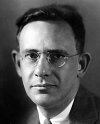 Edward Sapir was born in Lauenburg, Germany in 1884 to an orthodox Jewish family. He emigrated to the United States in 1889 and lived in New York City.
Edward Sapir was born in Lauenburg, Germany in 1884 to an orthodox Jewish family. He emigrated to the United States in 1889 and lived in New York City.
He received his Bachelors Degree in 1904 and his Ph.D. in 1909 from Columbia University where he came under the influence of Franz Boas. He taught briefly at the University of California and the University of Pennsylvania, he became Chief of Anthropology for the Canadian National Museum from 1910 to 1925, then went on to teach at the University of Chicago from 1925 to 1931 and Yale University from 1931 to 1939.
Although he is most often thought of as working with language, Sapir was also interested in cultural behaviorism and the development of personality. He is noted for his work with the ethnology and linguistics of Native American groups, and saw language as a verbal symbol of human relations. Dr. Sapir stressed that language shapes our perceptions, and he thought that understanding cultural behavior was impossible unless its development through language was thoroughly traced.
Even more than the facts of the fields he studied, Sapir was interested in the more abstract connections between personality, verbal expression and socially determined behavior. He was one of those rare individuals who was brilliant and devoted, yet expressed himself clearly and modestly, and attempted to pass on his love, specifically that of anthropology. Edward Sapir inspired literally thousands of students over his too-short career; so profound was his effect on them that many of his now well-renowned former students put together a collection of their own essays based on his studies, entitled Culture, Language, and Personality, and dedicated it to him.
After reviewing some of his writings, one can draw out and learn from some of Sapir’s more influential ideas, such as: Nothing in language is perfectly static. It is always changing, due to a phenomenon Sapir called “The Language Drift.” Although the parts of language that change most quickly often seem to be the most important parts of that language, they usually show themselves to be less fundamental than the slower-changing parts once the groups have grown to be mutually alien forms of speech.
It is an illusion that reality adjusts without language or that languages are just incidental means of solving problems of communication. In fact, the “real world” is, to a large extent, unconsciously built up on the language habits of the group. We see, hear and experience what we do largely because the language habits of our culture predispose certain choices of interpretation. We are at the mercy of our form of expression… our language.
The most important aspect of our interpersonal communication may be our wordless, sometimes unconscious body language read by others in social situations.
Edward Sapir produced an extremely large volume of writing over his lifetime. Also, many of his main themes are discussed by his former students in the aforementioned book Language, Culture, and Personality.
Sapir is best known for his work with Benjamin Lee Whorf on what has come to be known as the Sapir-Whorf Hypothesis.
Edward Sapir died on February 4, 1939.
Major Works of Edward Sapir
– Wishram Texts (1909)
– Language: An introduction to the study of speech (1921)
– Nootka Texts (1939)

complete article, i love it
I’m very happy to read this. This is the type of manual that needs to be given and not the random misinformation that’s at the other blogs. Appreciate your sharing this greatest doc.